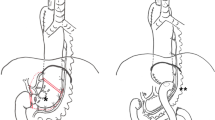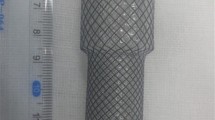Abstract
A 64-year-old female was evaluated for dysphagia, revealing a squamous cell carcinoma of the mid-esophagus. Tumor was staged as T3-4N2M0. She was treated by neoadjuvant chemoradiotherapy and after an interval of six weeks she underwent a three stage thoraco-laparoscopic esophageal resection with a cervical anastomosis. On the 8th postoperative day patient developed an infection of the cervical wound.
Access provided by Autonomous University of Puebla. Download chapter PDF
Similar content being viewed by others
Keywords
Diagnosis and Indication for Surgery
A 64-year-old female was evaluated for dysphagia, revealing a squamous cell carcinoma of the mid-esophagus. Endosonography, CT scan of thorax and abdomen, and PET-CT staged this carcinoma as cT3-4N2M0. The patient was treated by neoadjuvant chemoradiotherapy. This resulted, clinically and on the PET CT scan, in a significant reduction in tumor size and regional lymph nodes.
After a period of 6 weeks, she underwent a three-stage two-field lymphadenectomy thoraco-laparoscopic esophageal resection in prone position with a cervical anastomosis.
Postoperative Course: Identification and Treatment of the Complication
The patient started oral feeding the 5th day after the operation; on the 8th day she developed an infection of the cervical wound. Because of the aspect of the drained saliva and leak of air, a cervical anastomosis leakage was obvious. The patient was initially treated by care of the wound and jejunostomy feeding, but persistence of leakage for more than 10 days was reason to perform a CT scan that showed an adequately drained leakage from the proximal mediastinum (Fig. 2.1). Because of continuous leakage a stent was inserted at the level of the anastomosis. After placing the first stent, the wound continued to leak and a swallow X-ray showed dislocation of the stent and the presence of leak. A new endoscopy was performed, the old stent removed, and a new stent placed (Fig. 2.2). The leakage disappeared immediately and the patient could start step-by-step oral feeding. On the 31st postoperative day, she was discharged on condition of oral feeding and 1 L feeding through the jejunostomy. The stent was removed at the outpatient clinic 2 weeks after a confirmation by endoscopy that the anastomotic defect was closed.
Pathological outcome showed no vital rest of a tumor in the specimen, and all 15 lymph nodes scored negative for cancer.
Discussion
Treatment of a cervical leakage of an esophago-gastric conduit anastomosis is mostly conservative and consists of drainage of the wound, followed by care of the wound, and jejunostomy feeding. By doing so, a controlled fistula is created and leakage will stop in several days. There are two exceptions to this treatment (Illustration 2.2). First, if the leakage descends into the mediastinum with mediastinitis and second, if the cervical fistula lasts for a long period of time, perhaps longer than 10 days with persistence of a high production.
Indication for the use of a cervical stent was in the present case the persistence of the leakage and the imaging on the CT scan of the presence of a leak, adequately drained in the high mediastinum. There was a relative indication for placing a stent; probably the continuation of the conservative treatment had lead to closure of the fistula. One of the possible advantages of the stent over conservative treatment is the possibility of avoiding late stenosis. Dislocation of the stent is a well-known complication, especially because the space to place the stent distal of the crycopharingeus muscle is very small. Placement of the stent will permit patient from the beginning to ingest liquids and bland diet. The question arises how long the stent will be kept in place in order to close the leakage and avoid stenosis—probably between 4 and 6 weeks [1]. The incidence of anastomotic leakage after esophagectomy with cervical anastomosis is reported to be around 14 % [2]. A recent meta-analysis of randomized trials comparing cervical with thoracic anastomosis showed a higher incidence of leakage in patients with cervical anastomosis [3]. A report of 242 patients who underwent transthoracic esophagectomy with a cervical anastomosis, demonstrated an incidence of leakage in 11.1 % of the patients and only 50 % of the patients with leakage developed mediastinitis [4].
References
Scheepers JJ, van der Peet DL, Veenhof AA, et al. Systematic approach of postoperative gastric conduit complications after esophageal resection. Dis Esophagus. 2010;23:117–21.
Hulscher JBF, van Sandwick JW, de Boer AG, et al. Extended transthoracic resection compared with limited transhiatal resection for adenocarcinoma of the esophagus. N Engl J Med. 2002;347:1662–9.
Biere SSAY, Maas KW, Cuesta MA, van der Peet DL. Cervical or thoracic anastomosis after esophagectomy for cancer: a systematic review and meta-analysis. Dig Surg. 2011;28:29–35.
Korst RJ, Port JL, Lee PC, Altorki NK. Intrathoracic manifestations of cervical anastomotic leaks after transthoracic esophagectomy for carcinoma. Ann Thorac Surg. 2005;80:1185–90.
Author information
Authors and Affiliations
Corresponding author
Editor information
Editors and Affiliations
Rights and permissions
Copyright information
© 2014 Springer International Publishing Switzerland
About this chapter
Cite this chapter
Biere, S.S.A.Y. (2014). Case on Cervical Leakage of an Esophago-gastric Conduit Anastomosis. In: Cuesta, M., Bonjer, H. (eds) Case Studies of Postoperative Complications after Digestive Surgery. Springer, Cham. https://doi.org/10.1007/978-3-319-01613-9_2
Download citation
DOI: https://doi.org/10.1007/978-3-319-01613-9_2
Published:
Publisher Name: Springer, Cham
Print ISBN: 978-3-319-01612-2
Online ISBN: 978-3-319-01613-9
eBook Packages: MedicineMedicine (R0)







